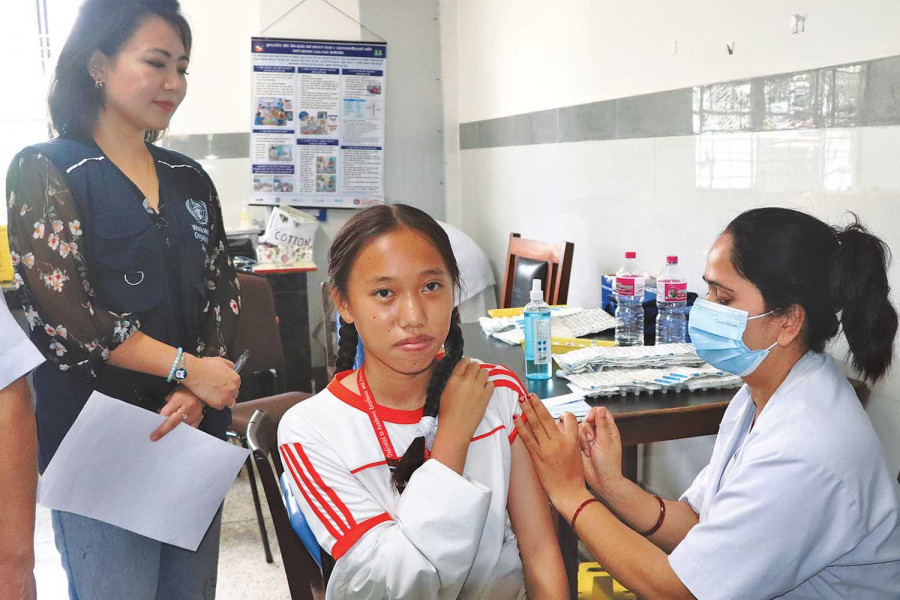Health
Health workers to visit schools to jab over 3,000 girls, who missed second HPV vaccine dose
The girls between 14 and 15 years received the first dose but did not show up for the second shot.
Post Report
Over 3,000 girls between 14 and 15 years who were given the first dose of the human papillomavirus (HPV) vaccine did not show up to take the second dose.
Due to the low uptake of the second dose, the Ministry of Health and Population has suspended the vaccination programme for now.
“We are preparing to send health workers to schools to administer the second dose of the vaccine to girls who got the first dose but did not show up to receive the second dose,” said Dr Abhiyan Gautam, chief of the Immunisation Section at the Family Welfare Division of the Department of Health Services. “We know that those who have not yet sought the second dose will not come to hospitals for vaccination.”
According to the health ministry’s data, 9,980 girls between 14 and 15 years of age from all seven provinces were jabbed with the first dose of HPV vaccine under a pilot programme, launched in September last year.
Human papillomavirus is a viral infection that spreads through skin contact. The virus causes cervical cancer, which is the second-most common cancer in the developing world and a major cause of death among Nepali women. Hundreds of women get diagnosed with cervical cancer every year in Nepal.
According to the BP Koirala Memorial Cancer Hospital in Bharatpur, more than 700 women suffering from cervical cancer seek treatment at the hospital every year.
HPV vaccination was also included in the government’s policies and programmes for the fiscal year 2023-24.
Doctors say most cervical cancer cases are associated with the HPV, a sexually transmitted infection and that widespread immunisation could reduce the impact of cervical and other cancers caused by the HPV worldwide.
Countries like Bhutan, Sri Lanka, Thailand and the Maldives have introduced the HPV vaccine nationally while India and Indonesia have introduced it in some districts.
In 2016, Nepal piloted HPV vaccination in Chitwan and Kaski districts. All girls aged 11 to 13 years were then given two doses of the vaccine.
Experts say early treatment prevents up to 80 percent of cervical cancer.
Meanwhile, health ministry officials said that a nationwide HPV vaccination drive is likely in the third quarter of 2024. The ministry plans to inoculate around 1.7 million girls between 10 and 14 years with HPV vaccine through nationwide drives, and also make it a part of regular immunisation.
According to officials, the Global Alliance for Vaccine and Immunisation (GAVI) has agreed to provide HPV vaccine doses. They said that once the campaign is completed, the HPV vaccine will be included in the government’s routine immunisation programme.
Nepal had submitted a proposal to GAVI in July last year requesting for HPV doses for free so that the vaccine could be included on the regular immunisation list. Ministry officials say they have proposed a budget for nationwide HPV vaccination campaigns in 2024.
Officials say that GAVI has already agreed to provide required doses of vaccine, but the problem is their availability.
The World Health Organisation says HPV vaccination is recommended as part of a coordinated strategy to prevent cervical cancer and other diseases caused by the virus.
The UN health body says HPV is responsible for more than 70 percent of the cervical cancer cases in women. Countries that have included the HPV vaccine in their regular immunisation list have successfully reduced cervical cancer cases in women, according to doctors.
Meanwhile, the health ministry has started the ‘big-catch-up’ campaign throughout the country, aiming to inoculate children under five years who have either missed scheduled doses or have not completed a vaccine series. Under the programme, health workers including female community health volunteers will track children who have not completed all doses of routine vaccines.
Every year, the ministry launches a month-long campaign to boost the coverage of routine vaccines.
Childhood immunisation is the number one priority of the government, under which 13 types of vaccines are given against a range of diseases such as measles-rubella, pneumonia, tuberculosis, diphtheria, pertussis, tetanus, hepatitis B, rotavirus, Japanese encephalitis and typhoid under the regular immunisation programme, free of cost.
Regular immunisation is one of the most successful programmes in Nepal, with a high coverage rate. The country has demonstrated remarkable progress in reducing the under-five mortality rate and the regular immunisation programme is credited with that.
However, a report of the Nepal Demographic and Health Survey-2022 carried out by the Ministry of Health and Population showed that at least four percent of the children aged between 12 and 23 months have received no vaccine at all. This figure was one percent in 2016.




 16.12°C Kathmandu
16.12°C Kathmandu













